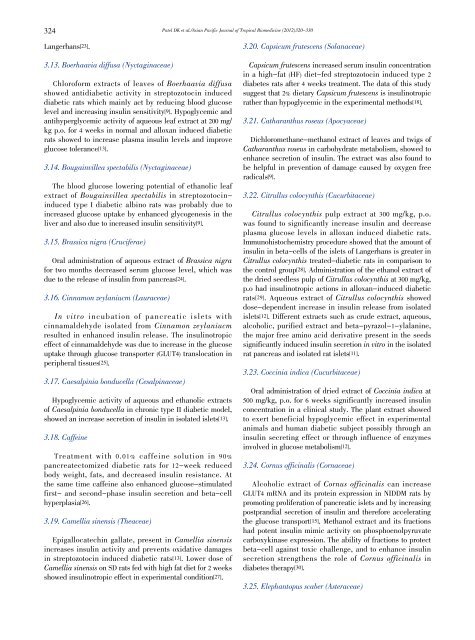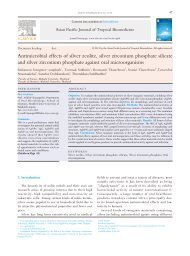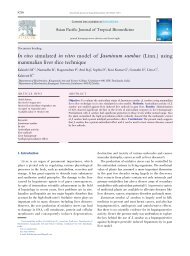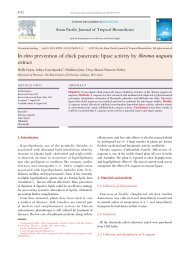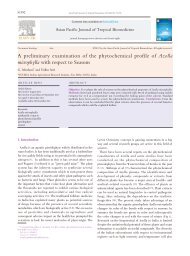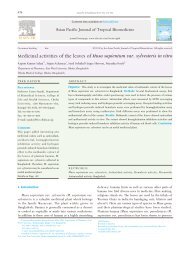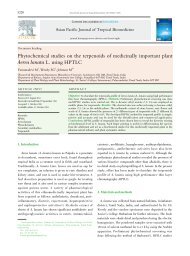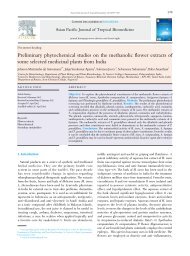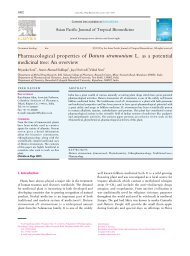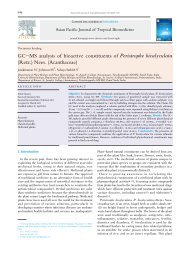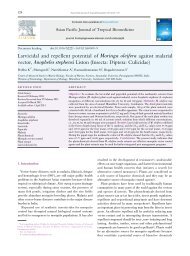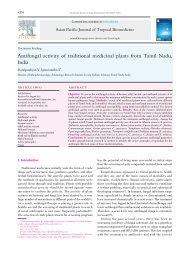An overview on antidiabetic medicinal plants having ... - Apjtb.com
An overview on antidiabetic medicinal plants having ... - Apjtb.com
An overview on antidiabetic medicinal plants having ... - Apjtb.com
You also want an ePaper? Increase the reach of your titles
YUMPU automatically turns print PDFs into web optimized ePapers that Google loves.
324<br />
Langerhans[23].<br />
Patel DK et al./Asian Pacific Journal of Tropical Biomedicine (2012)320-330<br />
3.20. Capsicum frutescens (Solanaceae)<br />
3.13. Boerhaavia diffusa (Nyctaginaceae)<br />
Chloroform extracts of leaves of Boerhaavia diffusa<br />
showed <strong>antidiabetic</strong> activity in streptozotocin induced<br />
diabetic rats which mainly act by reducing blood glucose<br />
level and increasing insulin sensitivity[9]. Hypoglycemic and<br />
antihyperglycemic activity of aqueous leaf extract at 200 mg/<br />
kg p.o. for 4 weeks in normal and alloxan induced diabetic<br />
rats showed to increase plasma insulin levels and improve<br />
glucose tolerance[13].<br />
3.14. Bougainvillea spectabilis (Nyctaginaceae)<br />
The blood glucose lowering potential of ethanolic leaf<br />
extract of Bougainvillea spectabilis in streptozotocininduced<br />
type I diabetic albino rats was probably due to<br />
increased glucose uptake by enhanced glycogenesis in the<br />
liver and also due to increased insulin sensitivity[9].<br />
3.15. Brassica nigra (Cruciferae)<br />
Oral administrati<strong>on</strong> of aqueous extract of Brassica nigra<br />
for two m<strong>on</strong>ths decreased serum glucose level, which was<br />
due to the release of insulin from pancreas[24].<br />
3.16. Cinnam<strong>on</strong> zeylaniucm (Lauraceae)<br />
In vitro incubati<strong>on</strong> of pancreatic islets with<br />
cinnamaldehyde isolated from Cinnam<strong>on</strong> zeylaniucm<br />
resulted in enhanced insulin release. The insulinotropic<br />
effect of cinnamaldehyde was due to increase in the glucose<br />
uptake through glucose transporter (GLUT4) translocati<strong>on</strong> in<br />
peripheral tissues[25].<br />
3.17. Caesalpinia b<strong>on</strong>ducella (Cesalpinaceae)<br />
Hypoglycemic activity of aqueous and ethanolic extracts<br />
of Caesalpinia b<strong>on</strong>ducella in chr<strong>on</strong>ic type II diabetic model,<br />
showed an increase secreti<strong>on</strong> of insulin in isolated islets[13].<br />
3.18. Caffeine<br />
Treatment with 0.01% caffeine soluti<strong>on</strong> in 90%<br />
pancreatectomized diabetic rats for 12-week reduced<br />
body weight, fats, and decreased insulin resistance. At<br />
the same time caffeine also enhanced glucose-stimulated<br />
first- and sec<strong>on</strong>d-phase insulin secreti<strong>on</strong> and beta-cell<br />
hyperplasia[26].<br />
3.19. Camellia sinensis (Theaceae)<br />
Epigallocatechin gallate, present in Camellia sinensis<br />
increases insulin activity and prevents oxidative damages<br />
in streptozotocin induced diabetic rats[13]. Lower dose of<br />
Camellia sinensis <strong>on</strong> SD rats fed with high fat diet for 2 weeks<br />
showed insulinotropic effect in experimental c<strong>on</strong>diti<strong>on</strong>[27].<br />
Capsicum frutescens increased serum insulin c<strong>on</strong>centrati<strong>on</strong><br />
in a high-fat (HF) diet-fed streptozotocin induced type 2<br />
diabetes rats after 4 weeks treatment. The data of this study<br />
suggest that 2% dietary Capsicum frutescens is insulinotropic<br />
rather than hypoglycemic in the experimental methods[18].<br />
3.21. Catharanthus roseus (Apocyaceae)<br />
Dichloromethane-methanol extract of leaves and twigs of<br />
Catharanthus roseus in carbohydrate metabolism, showed to<br />
enhance secreti<strong>on</strong> of insulin. The extract was also found to<br />
be helpful in preventi<strong>on</strong> of damage caused by oxygen free<br />
radicals[9].<br />
3.22. Citrullus colocynthis (Cucurbitaceae)<br />
Citrullus colocynthis pulp extract at 300 mg/kg, p.o.<br />
was found to significantly increase insulin and decrease<br />
plasma glucose levels in alloxan induced diabetic rats.<br />
Immunohistochemistry procedure showed that the amount of<br />
insulin in beta-cells of the islets of Langerhans is greater in<br />
Citrullus colocynthis treated-diabetic rats in <strong>com</strong>paris<strong>on</strong> to<br />
the c<strong>on</strong>trol group[28]. Administrati<strong>on</strong> of the ethanol extract of<br />
the dried seedless pulp of Citrullus colocynthis at 300 mg/kg,<br />
p.o had insulinotropic acti<strong>on</strong>s in alloxan-induced diabetic<br />
rats[29]. Aqueous extract of Citrullus colocynthis showed<br />
dose-dependent increase in insulin release from isolated<br />
islets[12]. Different extracts such as crude extract, aqueous,<br />
alcoholic, purified extract and beta-pyrazol-1-ylalanine,<br />
the major free amino acid derivative present in the seeds<br />
significantly induced insulin secreti<strong>on</strong> in vitro in the isolated<br />
rat pancreas and isolated rat islets[11].<br />
3.23. Coccinia indica (Cucurbitaceae)<br />
Oral administrati<strong>on</strong> of dried extract of Coccinia indica at<br />
500 mg/kg, p.o. for 6 weeks significantly increased insulin<br />
c<strong>on</strong>centrati<strong>on</strong> in a clinical study. The plant extract showed<br />
to exert beneficial hypoglycemic effect in experimental<br />
animals and human diabetic subject possibly through an<br />
insulin secreting effect or through influence of enzymes<br />
involved in glucose metabolism[12].<br />
3.24. Cornus officinalis (Cornaceae)<br />
Alcoholic extract of Cornus officinalis can increase<br />
GLUT4 mRNA and its protein expressi<strong>on</strong> in NIDDM rats by<br />
promoting proliferati<strong>on</strong> of pancreatic islets and by increasing<br />
postprandial secreti<strong>on</strong> of insulin and therefore accelerating<br />
the glucose transport[15]. Methanol extract and its fracti<strong>on</strong>s<br />
had potent insulin mimic activity <strong>on</strong> phosphoenolpyruvate<br />
carboxykinase expressi<strong>on</strong>. The ability of fracti<strong>on</strong>s to protect<br />
beta-cell against toxic challenge, and to enhance insulin<br />
secreti<strong>on</strong> strengthens the role of Cornus officinalis in<br />
diabetes therapy[30].<br />
3.25. Elephantopus scaber (Asteraceae)


